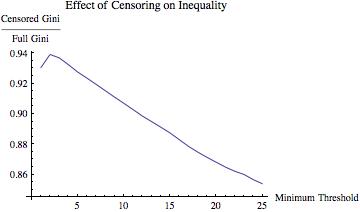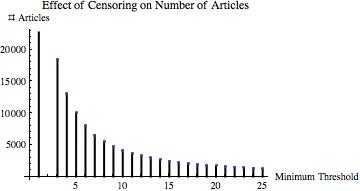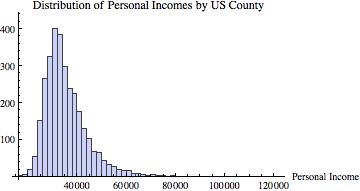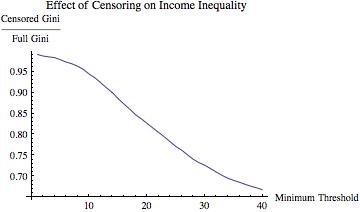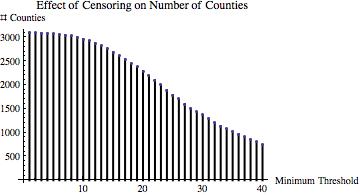The IRS scandal, and in particular the handling (or, mishandling) of it by President Obama’s counsel, Kathryn Ruemmler, has raised a classic question: what did the President know, and when did he know it? In my mind at least, the question is predicated on the presumption that the president ought to know everything that is going on in the federal government. After all, he is the administrator-in-chief, “the CEO,” the boss, the decider, the frickin’ POTUS!
A key point to remember through all such “management scandals” such as this is that the federal government is not a business, and particularly not the simplistic understanding of what “a business” is. The reality is that the effectiveness of government can not be properly judged in an unambiguously unidimensional fashion like a classic (again, simplistic) business can be judged by its profits. After all, one person’s “pork” is another’s “public purpose.”
That said, the real “mathofpolitics” point of this post is, even if the effectiveness of a government could be judged in a simple and uncontested unidimensional fashion, there are still situations in which the boss should not know everything that is going on. Mind you, this is not a feasibility/constraints argument such as “the boss is simply too busy to worry about that). Ironically, it is the opposite: there are situations in which the boss should not know some fact X precisely because the boss might care too much about X. In other words, there are situations in which voters/shareholders (i.e., “principals”) might want their politicians/CEOs to not know something. That is, the notion of plausible deniability is not exclusively a polite term for nefarious blame avoidance.
As I wrote a few days ago, political accountability is almost inherently an adverse selection problem. We as voters worry, and I think rightly, about the true motivations and goals of our representatives. It is a little complicated, but consider the following simple situation to understand the importance of plausible deniability.
Suppose that a politician is charged with reviewing applications for grants. Should the grant applications include the name of the applicants? Well, practical concerns answer this in the affirmative: how else can you award grants if you don’t to whom to award them?
So, supposing the applications have the names on them, should the names be removed prior to the politician’s review of the applications? That is, should the review be “blind” with respect to the applicants’ identities? Before you answer, “yes, it’s only fair,” think why this is the case, because the reason is (at least) two-fold. The more obvious of these two folds is based on the possibility that the politician is biased in favor (say) people who share his or her political views or partisanship. (And let’s reasonably suppose that such favoring would be bad/inefficient relative to the goals of the grant program.)
In this scenario (the heart of the adverse selection worries alluded to above), removing the names creates a “more efficient” award process because it removes something that the awarding of the grants should not be conditioned upon from the ultimate determination of the awards. This is a direct argument for “insulating” the politician from a piece of information about what’s going on in the government (i.e., who‘s getting grants?).
The second fold is more subtle. Suppose that the politician is unbiased. Technically, suppose that you almost certain that the politician is unbiased (i.e., the probability that the politician would exhibit favoritism is arbitrarily close to zero). In simple probabilistic/expected utility terms, the argument sketched above would suggest that the gain from removing the names from the applications is also arbitrarily close to zero. So, that argument would follow, you shouldn’t “pay much” or “go to much trouble” to remove the names from the applications, right?
Wrong. While this argument is correct “at the limit”—i.e., when the politician is absolutely, positively, without a doubt known to be unbiased—it falls apart (in game-theoretic terms, “unravels”) when there is even a scintilla of a (perceived) chance that the politician is biased. The reason for this is that the politician, if he or she knows that the voters know that the politician can see the names, needs to worry about the voters inferring something (or “updating their beliefs”) about whether the politician is actually biased. If he or she awards “too many” awards to his or her buddies (or, if we think there are a few friends, a few enemies, and a third group of non-friends/non-enemies, if the politician awards “too few” awards to his or her enemies), then a sophisticated voter will have increased (and perhaps greatly increased) reason to believe that the politician is actually biased.
The actual effect of this dynamic—for example, whether it will lead to too many or too few awards being awarded—depends on the parameters of the problem (specifically, the net benefit of an extra award and the weight that voters think a biased politician assigns to helping friends/hurting enemies), but the key to this second fold of the argument is as follows:
An unbiased politician will (ironically) condition his or her decisions on the names of the applicants if the politician is known/believed by the voters to have had the names when making his or her decisions.
So, when an advisor goes to great lengths to make it known (i.e., tells others, records the facts, etc.) that he or she did not tell the politician “the names,” this is not necessarily a “cover up.” Rather, and particularly when the names are “politicized” (i.e., the awards are coming out in a biased way), this approach can be required (even if ultimately unsuccessful) to support a “de-politicized” decision process by the politician.
Another way to think of this is as follows: suppose that the politician chooses 10 awards, and the advisor, upon looking at the names in another room, realizes that the politician has given awards to 10 enemies. At first blush, one might think—well, heck, if the politician is unbiased, then he or she could be told this fact. But this is not true, because if this were a possibility, we (the voters) would (or should) wonder exactly whether the advisor told the politician that and the politician changed his or her mind/redid the awards whenever we see 10 of the politician’s friends receive awards.
Is this dynamic at play in the IRS scandal? Yes. It is at play throughout the federal government everyday. For example, the idea of the special prosecutor (or special counsel) is entirely based on it. Viewed from a strategic point, whether Obama should appoint a special counsel in this case is not unambiguous, as it could be akin to a Chamberlain moment vis-a-vis the House GOP, but I think I agree with Bill Keller that he should.
With that, I leave you with this.



